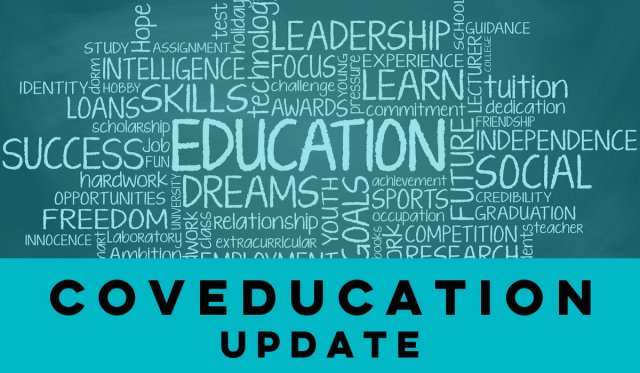
There’s a lot of Oklahoma education news to catch up on this week, from Gov. Kevin Stitt moving teachers to phase two of Oklahoma’s vaccine distribution plan to an updated audit of Epic Charter Schools showing the school could have shortchanged taxpayers an additional $823,000.
Don’t fret. We’ve made it easy to stay up-to-date with a collection of education headlines from reporters around the state in our coveducation recap.
Epic shortchanged taxpayers an additional $823,000
The Oklahoman’s Nuria Martinez-Keel reported this week that an updated audit of Epic Charter Schools shows the school could have overspent by an additional $823,772 on administrators’ salaries.
State Auditor and Inspector Cindy Byrd announced Wednesday that a second evaluation of Epic’s financial reports shows the school incorrectly classified as much as $9.73 million as non-administrative payroll, though it was paid as salaries to school administrators.
Epic denies it misreported any funds.
Stitt moves teachers up for vaccine, State Board cancels school report cards
NonDoc reported that during an Oklahoma State Board of Education meeting Thursday, board members unanimously approved suspending 2020-2021 school report cards owing to COVID-19.
Gov. Kevin Stitt announced adjustments on Thursday as well, moving pre-K through 12th grade teachers and support staff to phase two of the state’s COVID-19 vaccine distribution plan. Teachers were originally in phase three of the distribution hierarchy.
“We cannot lose another semester educating our young people,” Stitt said during the press conference. “My goal is to get every kid in school in person in January, however we need to do it.”
Stitt also suggested the State Board of Education could get involved in the process and provide pressure.
“The State Board could potentially pass some type of rule that could supersede some of the local decisions,” Stitt said.
OKCPS has tentative plans for spring semester
Oklahoma City Public Schools released an update from Superintendent Sean McDaniel on Friday stating that the district plans to begin the spring semester with all students in remote learning for two weeks. They plan to gradually begin bringing young learners and high-need student groups back to campus in an A/B setting on Jan. 19.
The district tentatively plans to have students in grades fifth through 12th return to in-person learning on an A/B schedule Feb. 1.
OKCPS has also started installing Needlepoint BiPolar Ionization systems in district facilities as an added layer of COVID-19 safety.
KFOR reported that McDaniel said the district was able to leverage federal CARES funding to add the ionization technology.
The system works to safely clean indoor air, leveraging an electronic charge to create a high concentration of positive and negative ions. These ions travel through the air continuously seeking out and attaching to particles, such as the coronavirus which is microscopic. As particles combine, they become large enough for them to be captured in the air filter and are able to be eliminated from the air more rapidly.
Attendance policies questioned
A report from Ben Luschen with Big if True this week looked at data from five Oklahoma school districts in order to put together an incomplete picture of how many students are showing up to class and passing during a semester that delivered a barrage of challenges to students and educators.
Five districts — Tulsa, Edmond, Union, Owasso and Skiatook public schools — provided most of the data. Ten, including Oklahoma City, Moore and Putnam City public schools, provided no data despite multiple requests by email and phone.
Does distance learning capability mean the end of snow days?
A report this week from StateImpact Oklahoma’s Robby Korth looked at how the pandemic is changing snow days for Oklahoma students.
A semester fractured by closures owing to COVID-19 infections and quarantines has caused districts like El Reno Public Schools to have to pivot school sites to distance learning at a dizzying pace.
El Reno Superintendent Craig McVay said that made the decision to have a snow day replaced by distance learning the logical decision.
However, El Reno isn’t alone, as dozens of districts around the state announced they’d be in distance learning because of winter weather.
Small school innovations helping computer science students stay ahead
COVID-19 has had an impact on computer science education. Not only has the pandemic interrupted the level of collaboration student programmers are able to undertake, students are also impacted by the basics.
Ryan Welton with News 9 reported that unlike other school districts’ distance learning growing pains, Maple Public Schools’ computer science curriculum was able to thrive in 2020, even in a rural district where internet access isn’t guaranteed.
This was with the help of some pre-pandemic alterations to the curriculum.
Grandparents raising students face extra challenges during COVID-19
The COVID-19 pandemic has added a new layer of difficulty for all families, but grandparents taking care of children have faced some particular challenges.
A report from NonDoc this week looks at the challenges these families are facing including helping students succeed in a virtual learning environment, sending children to school to potentially bring the virus home and considering what would happen if the guardian becomes ill with COVID.
Oklahoma education tweets of the week
Here's a thread on a few items of note that happened in #oklaed today:
— Robby Korth (@RobbyKorth) December 17, 2020
.@GovStitt announces #oklaed teachers and support staff will be elevated to Phase 2 in the vaccine distribution plan. https://t.co/bjj2O13ekr
— OSSBA (@OSSBAoklahoma) December 17, 2020
Stitt, and a majority of the state Board of Education members, have been strongly on the side of local control throughout COVID-19 re: mask policies, school calendars, etc. Yet, with in-person instruction, he says "it's time for everyone to get on board." #oklaed https://t.co/NseNr1dHTC
— Jennifer Palmer (@jpalmerOKC) December 17, 2020
https://twitter.com/mcvay51/status/1338658764417683456





















